QuestionQUESTION: I have been told by my new "natural hoof" farrier that my [never shod] 9 year old quarter horse has whiteline disease. He recommended to soak her feet in a boot filled with "LYSOL" every day possilbe til it's cleared up and then weekly thereafter for maintenance. Is this okay &/or do you have any suggestions of a cure/maintenance?
ANSWER: Lysol, when mixed with water, is fine for a soak. There are also other products out there such as "Clean Trax" that work well.
For maintenance correct trimming for the individual hoof is going to go further than anything else.
I would also encourage as much movement as possible coupled with a diet that is high in forage but low in sugars and carbs (grain).
I apologize for the delay in my answer to you. Caught a "virus" on the computer that actually exponentially reproduced itself so was offline for awhile! :( But, think all is well now. I hope!
:) -- Gwen
---------- FOLLOW-UP ----------
QUESTION: Good morning Gwen. I've never heard of "Clean Trax" What is it and where could it be purchased? Also, are alphfa pellets okay to feed[about 2 cups a day with 4 cups beet pulp plus her 2 lbs of sweet feed a day]. We have experienced some weight loss at the barn thru the winter, so that's why I've been feeding her the pellets plus extra coastal hay. Thanks, Rhonda
AnswerArgh! I did a search for Clean Trax and came up with Marjorie's site - forgot all about that. She has some awesome suggestions plus other alternatives to Clean Trax: I've copied here --
------------------------------------------
reatments for fungus:
Trim away all "shedding" or peeling frog material with a sharp hoof knife -- sharp so that you can cleanly cut away the diseased part. You may see deep, black cracks; trim till all the black is gone and all remaining frog is open to the air. This will let the soaking solution get to all infected areas. Be careful, some of the deeper cracks may be tender. Your horse may be sore in the heels for a few days, but frog grows back really fast when the fungus finally gets treated.
Clean Trax is a chlorine-related treatment that kills both the fungus and its spores. It is the treatment of choice in difficult cases and where the fungus has invaded the white line higher in the hoof capsule. Clean Trax is expensive and requires a very long soak which is hard to do with horses that don't stand still easily.
Clean Trax is available from KC La Pierre, 508-248-4444, from www.centaurforge.com (click on Hoof Care/Repair, then click Hoof Medications), and possibly elsewhere.
Clean Trax is applied by soaking the horse's feet for 45 minutes in a gallon of solution; then you wrap the feet in plastic bags for another 45 minutes to keep the fumes in. A severe infection may need more than one treatment. Gallon soaking boots are available. You can make a usable boot from about half of an inner tube with one end tied off.
Some other treatments that work well and are easier to do:
1) Borax cleaning powder (a laundry product, such as "20 Mule Team Borax" or "Boraxo"), is available at hardware stores and builders supply stores; overseas at the chemist. Borax works by changing the pH (acidity) of the frog to a more alkaline range so that the fungus is unable to reproduce. I found Borax to be successful, easy to deal with, and inexpensive. For typical cases, borax is my treatment of choice.
Use 1 Tablespoon borax powder in a bucket with enough water to cover the foot. Add 1 dropper of Calendula drops, and herb that helps with skin conditions, and soak 15 minutes, 4 to 10 times over several weeks to a month. On the in-between days you can soak a cotton ball with this solution and stuff it into the central sulcus. You can stop soaking when there is obvious new growth in the center of the frog.
2) People in the UK are using Zinc sulphate (sheep foot rot treatment) which can be soaked for a short time daily or even kept in a permanent foot bath that the (sheep, horses) walk through daily both for treatment and prevention.
3) Lysol cleaning solution can be used as a soak.
4) You can mix 50% Neosporin (or generic) triple antibiotic cream with 50% athlete's foot cream (clotrimazole 1%) and apply deep into the central sulcus with a 60 cc catheter syringe. Use daily until there is new frog growth.
5) You can insert Calendula cream or gel deep into the central sulcus, daily until there is new frog growth.
In my opinion, since fungus is likely a systemic infection, half the battle is to build the horse's deficient immune system; really healthy, unstressed horses don't seem to get fungus. I would suggest several or all of the following:
-- Add half a dropper of Calendula drops daily in the horse's dinner, also add to the soaking solution; use until the bottle is empty. Calendula is an herb that supports healing of skin tissues; hoof and frog are "skin." Other herbs may be available in other countries.
-- Give 30,000 units of vitamin A daily for several months. This is approximately the amount in a very large carrot, or in a "flake" of alfalfa hay. For horses with sugar restrictions, you can use vitamin A from your health food store instead of carrots. Vitamin A is important in healing skin tissues and for overall immune system health. It's important to supplement with Vitamin A in the winter, or any time the horse is not getting a substantial daily amount of green in its diet (grass, leaves, or hay that is quite green).
-- Dr. Ed Sheaffer, a naturopathic veterinarian, notes that an iodine deficiency is strongly implicated in all fungal infections, including rain rot and fungus in the hoof. A good way to include biologically available iodine in your horse's diet is to provide free-choice kelp meal, or any other seaweed you can get. Along with iodine, seaweed contains all the trace minerals because it grows in the ocean. Horses tend to eat a lot of it for the first few days to catch up on mineral deficiencies; then they nibble on it in much smaller amounts as needed, approximately 1 Tablespoon daily.
-- There are many other herbs that boost the immune system. I recommend you talk with your local herbalist, as herbs vary around the world. With some of them, be careful how long you give them; for example, Echinacea is a strong immune system builder, yet begins to deplete the body if used more than about a week. There are many "weeds" that support the immune system, including common ones like dandelion and plantain. If your horse's pasture is lacking in a variety of weeds, find a weedy spot elsewhere and do some occasional hand grazing there.
-- If there is a toe flare, this contracts of the heel, squeezing the frog together, so that the central sulcus becomes a crease where fungus lives easily. Keep the toe well backed-up so that the heels can de-contract.
-- Fungus (yeast) thrives on sugars. If you live in an area where the grasses tend to be high in sugars, see www.safergrass.org for suggestions. Eliminate "sweet feed" (grain with molasses) and if possible, eliminate grains, whose starches are nearly as attractive to fungus as actual sugars. Eliminate treats that contain sugar and flour.
There are areas where we keep horses, such as the northeastern and northwestern corners of the U.S., the U.K., and others, where the climate is so constantly wet that horses are always fighting off fungus infections. In these areas, at the wettest times, it may be more important to stable a horse overnight so its feet can dry out, than to keep it on pasture 24/7.
-------------------------------------------
Because White Line can be a combination of both bacteria AND fungus/yeast I would suggest that you gradually switch the sweet feed to a pelleted, low sugar/low starch feed. The Alfalfa pellets are fine - in fact, if you feed a good quality hay then Alfalfa pellets with Beet Pulp is all you'd need with a good vitamin/mineral supplement. If you need more calories for weight gain, add up to 2 cups of Vegetable Oil (cheap, 100% soybean oil) a day to the diet. Start off with just 1/4c daily and work up as you feel is needed. Those 2 cups of oil will add 4000 calories to the diet a day.
Hope this is all helpful to you.
:) -- Gwen

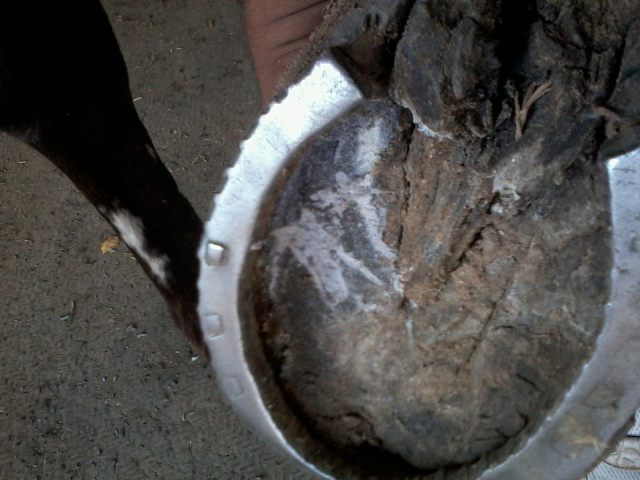 horrible hooves
Question
left fore right fore
hello sir.
horrible hooves
Question
left fore right fore
hello sir.
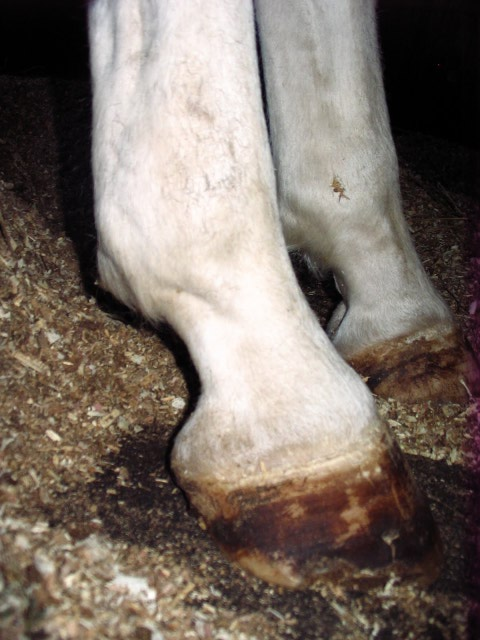 club foot
Question
club foot
hello sir, i believe that thi
club foot
Question
club foot
hello sir, i believe that thi
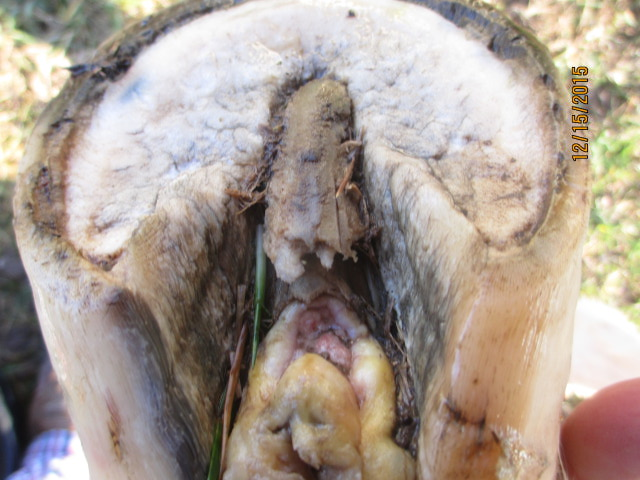 contracted hoof frog is almost gone
Question
frog
I have a paint gelding. I bought h
contracted hoof frog is almost gone
Question
frog
I have a paint gelding. I bought h
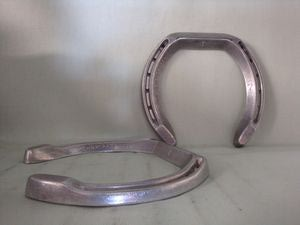 what type of shoe
Question
what type of shoe
hello sir, what type
what type of shoe
Question
what type of shoe
hello sir, what type
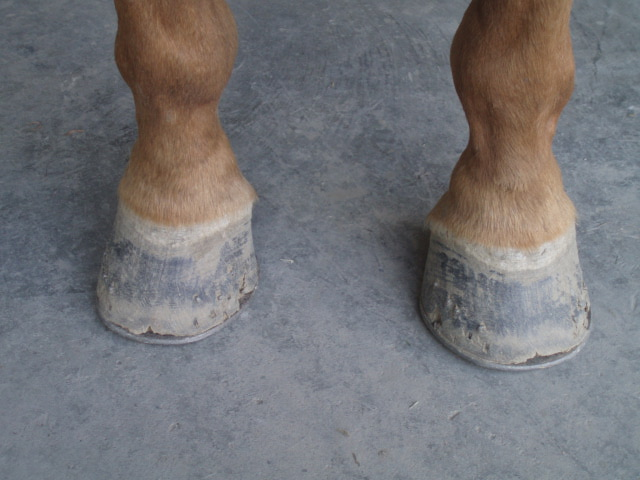 Is this white line?
Questionis this white line
is this white line &n
Is this white line?
Questionis this white line
is this white line &n